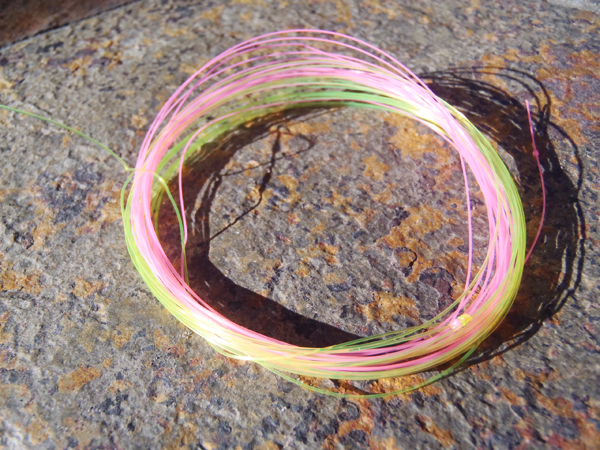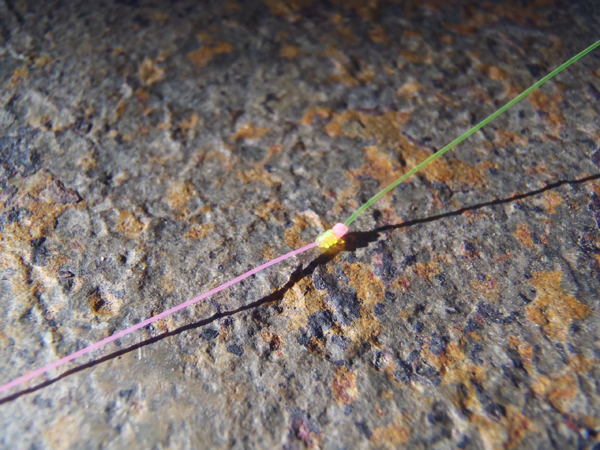Tenkara level lines are so thin that, by nature, they’re hard to see. To combat this, manufacturers dye their lines in bright colors to make them more visible. But conditions can change throughout the day (and even from spot to spot) so rarely is one color trackable in every situation.
It could suddenly become overcast, rendering a particular color invisible, or you could move to a spot with a lot of glare on the water or different substrate that makes that line you’ve been using all day disappear. I’ve found that I can usually get away with just two colors and switch between them when needed. But I also hate stopping to switch lines. Even though switching lines is much faster in tenakra than in conventional fly fishing, I’d still rather spend that time fishing.
So, it finally occurred to me: why not just make one line that is two colors? Here’s how it works.
Pick your two favorite colors–the two you find yourself switching between the most to get the best visibility. This will be different for everyone but I like orange and pink or yellow and pink. Take the overall length of your line and divide it in half. Cut equal lengths of both colors (in the same diameter of course) and tie them together.
So, if you want an 18 ft. line, cut 9 feet of one color, 9 feet of a different color, and tie them together with a blood knot.
Now, when you’re on the stream, you can switch colors without changing lines. Simply detach the tippet and fly from the end of the line, detach the line from the lilian, and flip the line around so the other color is at the business end. If you’re using a slip knot for the tippet, you should be able to just loosen it and reattach it to the line without having to clip anything or tie any new knots.
The process is fast and doesn’t involve winding or unwinding of line spools. Plus, I don’t have to carry separate lines just to change color.
I’m calling it the Hi-vis Bi-vis Line (HVBV). I may not be the first person to have thought of this (at least, I haven’t seen it posted anywhere), but it works and if you’ve found a couple of colors that you consider your go-to colors, it might be worth a try.










I hate the knots on the line, especially when fish under canopies or near the grass. You are lucky to fish at the open waters, I think.
Oleg,
Yes, I am lucky. All of my local streams are wide open and perfect for tenkara! 🙂 I can fish long lines and not have to worry about getting snagged or knots getting caught up in brush. I hope one day you can come to the U.S. and fish with me! colorado is tenkara-perfect.
I’ve been doing this for years but I use 3 colors: Pink, Yellow, Orange in that order. Great system for winter fishing when harsh light and shadows mix.
This also makes a great Euro-nymphing line.
I fish a lot with knotted tapered furled lines in all kinds of brush and have never had problems caused by knotted line segments. They fish just like level line. Knotted lines are not a big deal.
I’d be interested in a “best of” blog post that gave your top pick for a number of categories. For example, your current favorite mid weight level line, similar to what “thewirecutter.com” does for electronics.
Matt, Interesting idea. You mean something like my top picks for gear? Or my favorite post topics?
Hi Jason:
i really like your interest for finding solutions for common problems that we all face. I tried many ways to use the level lines, including the one that you mention. Still I have trouble to see the line.
I began again using the simple taper tenkara line (both sizes), and I realized that this line design is the most visible of all. I really like Daniel Galhardo’s philophy: Keep it simple, it works.
Thanks Martin. Furled lines certainly the most visible and cast very well but I really prefer level lines because they’re easier to keep off the water. Also, I prefer 16-20 ft. lines. I typically don’t fish lines the same length of the rod.
while I normally vehemently dislike knots in leaders, there is one advantage in hivis. you can make a highly visible sighter out of a 2 foot piece of hivis by tying figure eight knots two inch apart and lightly coating with Loons UV knot sense. Similar to but a diy competition czech nymph sighters. if you use sunline, the knots shine like diamonds in the sun when coating with Loons. a 6-12 inch sighter is plenty.
This would work with amnesia mono also.
a fyi- Hanak and other brand euro nymph bicolor is a soft mono with lots of stretch. It is a spool of fine mono that alternates pink/red to yellow using opaque dyes and is the most visible. However, it is not suitable for tenkara. It is high stretch for stiffer western euro rods. you will loose all feeling that tenkara rods give you. Not recommended for tenkara.
Hi, an even easier option is to have very short sections of contrasting mono at the tip of the casting line. So on a yellow main line you might have 4 inches of black amnesia and 4 inches of pink fluoro. Black is excellent for silvery reflective water and the other two between them contrast with every others ‘natural tones’ background.
Have to agree with John about knots – I don’t really find them to be an issue. I use knotted furled and knotted mono lines all the time. If I’m going to get stuck in the brush it is almost always the hook that’s the problem – not the knot.
I will say that knots do stink though if you’re fishing where there is lots of aquatic vegetation – such as spring creeks or summertime blue gill ponds.
Fishing tenkara – knots on the casting line shouldn’t (in normal circumstances) come into contact with the water at all 🙂 🙂 Just sayin….:)
I do accept, of course, that fishing stillwaters or for certain on-stream manipulations; some of your casting line will be on or in the water.